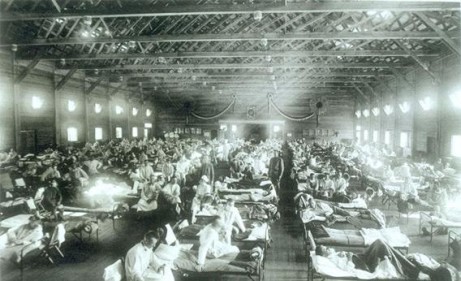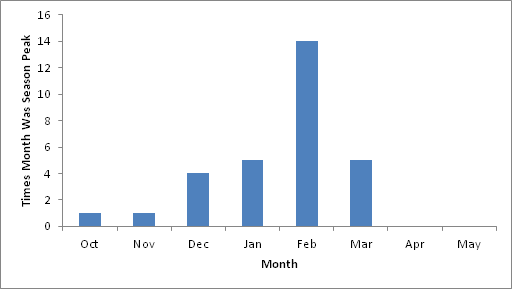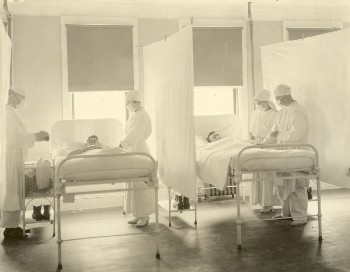Or women, for that matter. Or the poor kids. The Flu gets us all, sooner or later. Mostly it is just a rough spot with fatigue, dehydration, soar throat and congested lungs and that delirious in-and-out chills and fever thing best ridden out in bed.

(A ward at Camp Funston, Kan. showing the many ill patients who caught the 1918 Spanish influenza. Photograph by an unknown U.S. Army photographer.)
That is one of the reasons I have not been to see “Zero Dark Thirty” at the theater. Or the highly regarded “Lincoln,” or any of the other decent looking Hollywood diversions that are now appearing in wide release. I am conducting a low-level avoidance of public places, with the exception of the Willow, of course. Which is probably a mistake. Old Jim was hard down last week, unable to drink effectively, and confined to quarters. I hope he is rising out of the infection, phoenix-like, but this is a tough strain against those of us of a certain age.
Another pal is in the grip of it right now. Shivering and boiling by turns in Colorado, that square state has lost two of the twenty kids who have perished this year due to the Flu. There are vaccine shortages, which are expected to be resolved shortly. With a two week period required to boost the immune system, it may be too late to be much good.
The CDC still is telling us to get them. I may make a few calls today to see if shots are available, though I do not really want to go any place where there are a bunch of people shopping for flu-relief nostrums. The predominant current flu strain (there are, of course, multiple types) is something called “H3N2,” and while it appears to have good match to the flu strains in this year’s vaccine. H3N2 is high in virulence, and the CDC claims it has been around before, in the 2003-2004 season.
Here in Virginia, the wave started to hit in December, a month or two early, which hasn’t happened since the 2003-2004 season. Outbreaks have been reported in schools and nursing homes in all regions of the state but no children have died.

(Normative distribution of influenza cases by month. Data and chart from CDC).
I don’t have it- yet. I did not get the flue shot this cycle, and have not for a few years. I vividly remember the 2004 season. That was the year I got it and realized what it was going to be like, someday, when the ache was so deep, the coughing so severe, the delirium so profound that I was horizontal for days, and quite prepared to expire.
It is startling to note the number of Americans who are not going to get through this season alive. It is too soon to tell how many more will succumb to the flu this year. No one can say what the total is going to be this year- we look to be on the high side of the norm as far as deaths go. The regression model developed by the CDC claims an annual average of 41,400 deaths to the bug between 1979–2001.
That seems like a lot- think of the entire crowd at an NCAA Division II football game getting wiped out in a few weeks- but as a percentage of the total population it is not much. It is nothing to get freaked out about, unlike some of the other idiocy abroad in the land, and is a matter of being prudent. Remember to wash your hands and avoid crowds are probably the best defense. Those two things which are just good ideas all by themselves.
Sometimes the strain that comes around is really bad, which it is not, so far, though it is edging over the boundaries of the “epidemic.”
It could be worse. Much worse. I have not been freaked out by public health issues since I retired from a job on the Secretary’s staff at the Department of Health and Human Services. That position was way too close to some really scary stuff for comfort. We dealt with the anthrax thing, and the SARS thing, and hysteria over every finding of ominous white powder.
I got a chance to appreciate the nature of epidemiology and the sentinel warning system the National Institutes of Health and CDC used to identify and track disease.

(Navy hospital in 1917. Photo USN.)
The professionals know that really crazy things can happen, just like the last time the Bad Flu came around.
World War I was getting to the end-game, millions of men were overseas, living in mass barracks or the mud of the front. The Spanish Flu got a free ride around the globe with the mass movements of people.
It was remarkable. I mentioned the that scary total of flu deaths this year- but is still infinitesimal compared to the 305 million citizens of this nation.
I was looking at the totals from the great pandemic of 1918-19. That is the only year in the 20th Century in which the US population declined.
As of July 1, 1917, there were 103,268,000 Americans. As of the next year, the population had declined by 60,000, to 103,208,000.
The Spanish Flu was many things. Unusual in the population it targeted, which was not the usual combination of old and young, but rather it was most virulent against those of working age. It was frankly quite incredible.
Maybe fifty million died around the world. In the US alone, reliable number suggest 675,000 died from the flu. Based on the percentage of the population, that is over one half of one percent of all citizens died- or in terms of today’s population, it would represent nearly two million fatalities.
Two million.
I could tell you the stories of that horrific season, but there is no time this morning, and there are other things to worry about. Plus there is that work thing. But if you are feeling a little achy, fatigued, and congested, just don’t go to the office. Stay hydrated. Cough into your elbow instead of your hand.
Avoid crowds. Stay in bed.
We will be back with other things to get hysterical about tomorrow.
Copyright 2013 Vic Socotra
www.vicsocotra.com
